
|   |

|   |
Nrityabharati Fest: The Vasanta of Dances
- Dr S. D. Desai
e-mail: sureshmrudula@gmail.com February 8, 2015 With the joyous ambience it created and each day’s performance getting a standing ovation, Nrityabharati’s 12th four-day national dance festival (Jan 27 to 30) in the 55th year of Elakshi Thakore’s Bharatanatyam dance centre grew into a veritable Vasantotsava. Judging by the simultaneous dance festivals being held in Vadodara and Rajkot, to mention those nearer Ahmedabad, Gujarat is in a mood to celebrate the season during the cold nights of its fag end. 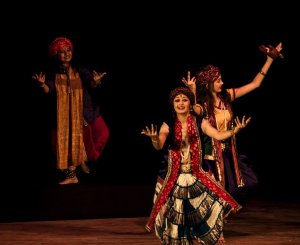  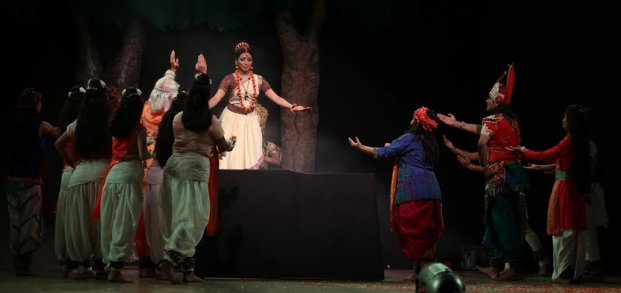 The curtain went up promisingly with the host’s Vaidehi Vanavaas, a self-contained segment of half the length of the well-known original two-and-a-half hour long Sitayana, set to music by the celebrated pioneer, along with Avinash Vyas, of Gujarati Sugam Sangeet compositions of instant recognition, Ninu Mazumdar. Integral to these compositions is the expressively ringing voice of Kaumidi Munshi, who is the mainstay of the revival of this nrityanaatika tradition. Associated with the delectably lilting songs viewers hummed along with the singers and the serenely dignified ambience of the Valmiki Ashram where Luv and Kush along with other glowingly agile children with unfaltering attention learn dhanurvidya are many other names, most prominent among which is that of Pt. Ravishankar. Janardan Raval’s voice has the quiver of feeling and Uday Mazumdar lends appropriate expression. All this, and more, places the music of Vaidehi Vanavaas at an elevated level. With the exception of two senior dancers, Nirali Thakore and Nirali Trivedi, both at ease in their roles, one as Sita and the other as Sootradhar, and a lone (gallant) boy as Lakshman, the rest are all budding teenage dancers - and yet the ever zestful Chandan Thakore quite measures up to the level through his choreography and setting. He has the able guidance and direction from Charugeeta Shukla, who has directed the scenes as well as excerpted and coordinated the music. It is her script Tushar Shukla gives voice to with clarity. There is a fine balance, Charugeeta would assert, between the venerated Ram and his counterpart Sita in Sitayana, and appropriately there should be. In Vaidehi Vanavaas, however, to my personal liking, Sita emerges as a strong woman with all feminine traits as mother and wife - and as the daughter of Mother Earth. Avinash Vyas’s simple song sung by Lakshman spells out the theme of the piece: ‘Ram tame Sitaji-ni tole na aavo’. Even as he extols the elder brother’s virtues, he fondly says, in her forbearance and silent sacrifice ‘You bear no comparison with her!’ The folklore in any part of the world remains intact in its collective memory. Viewers and listeners relate to it because the legendary characters and their personal qualities, worth emulation, are part of their way of life. In Vaidehi Vanavaas, the viewers/listeners relate to them and the episodes because classical dance combines here with folk dance elements as well. The intermittent kathan shailee - singing narrative style - with one girl symbolically having a kartaal in hand gives the presentation an endearing folk tale touch. Nitpicking is always possible, but where the overall impact is highly agreeable it has to be brushed aside. Sculpted reliefs 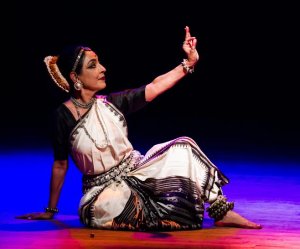 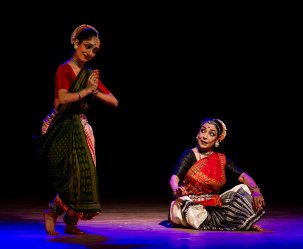 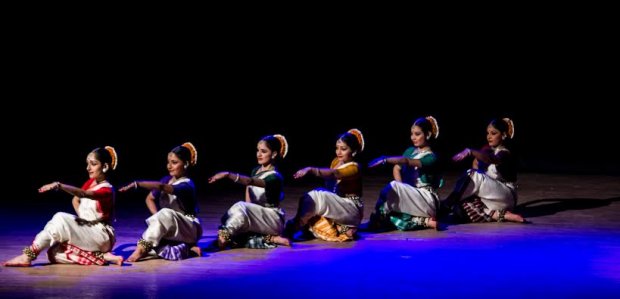 Drama at times reduces a poetic work to a little more than physical action. Dance with its intricate abhinaya, dhwani and suggestion tends to retain and at times heighten its beauty. One realizes this while watching Madhavi Mudgal’s choreographed version of Kalidasa’s epic Kumarasambhavam staged on the second day of the festival. Odissi’s elegance and lyrical flow of movement eminently well carries the theme of the triumph of love along with the Mahakavi’s splendorous descriptions of nature and portrayals of characters supposed to be divine and yet essentially human. The aura of the happenings focussing on Shiva and Parvati in the magnificent ambience of the Himalayas finds pleasing expression through the well-trained dancers’ mudras, the universal theme through their bhavas and its irresistible lyricism through the sensual fluidity of the form. The story it unfolds is of Parvati enamoured of the ascetic Shiva getting repulsed and yet remaining steadfast finally winning his abiding love through rigorous penance. A familiar story, as in the case of most great literary works. It is the form that pleases - in this case, Odissi, in which at times the scenes give the impression of sculpted reliefs. No wonder, since this classical dance is based on such reliefs in temples. Topical in its theme, Vasant from Rutu-Samhaar celebrates the onset of spring with its exhilarating images of blossoming trees, fragrant winds, buzzing bees, jasmine flowers and young women glowing with feminine charm. The beginning of the performance is with Ganga-stavan in praise of the Ganga that is regarded as a symbol of rejuvenation and a source of empowerment. There are two delightful dance pieces set to Madhup Mudgal’s music compositions that follow. In Vistaar, varying group formations synchronized with changing rhythmic patterns. Another abstract piece Vaadya Vaividhya gives a delectable taste of Orissa’s rich indigenous instruments - khanjani, khol, nagara, mardal, temple bells and all - which spells a celebratory mood and the dancers joyously visualize it. Images of Sohamasmi, a spellbinding piece in which music and lights were inseparable from the dance performance, Madhavi Mudgal, a worthy disciple of Kelucharan Mohapatra, performed here fifteen years ago kept coming to the mind. In chaukh, tribhanga, abhinaya and flowing movement - signature traits of Odissi - even now, she seemed frozen in time. Age, it seems, cannot wither the grace of an artist. The damsels, who seemed to have leapt out of the columns of the temples of Orissa, formed quite a constellation! Arushi Mudgal, in her first appearance in Ahmedabad, gave a cherished portrayal of the slender shailadhiraja- tanaya, in the poet’s words, ‘like the lotus blooming under the sun’! Beauteous group choreography 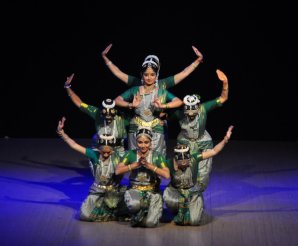  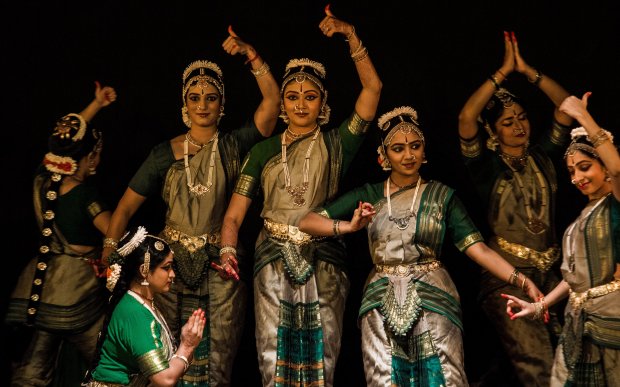 Nrityabharati has made Guru B. Bhanumati one of the household names for young dancers and dance lovers of Ahmedabad. With the proximity she developed and with her easy felicity of expression both through dance and verbal communication five years ago, she left over thirty five participants at a workshop she conducted raring to learn more from her. On the concluding day, I recall, a keen participant observed, “We got a new nazariya from her to look at the dance form we have been pursuing.” Unassuming in her demeanour, B. Bhanumati has a rare sense of visualization and getting her disciples to present group formations of near perfection. Whether it is a Tyagaraja kriti on Goddess Saraswati, Purandaradasa’s Chandrachood Shankar Shiva-Parvati or dainty excerpts from the Ramayana, the lines - of hastas and of varying group formations - characteristic of Bharatanatyam assume such unparalleled beauty that not for a moment the viewer would like to turn eyes away from the performance. The lines are no compass-measured geometric lines. Looking so, they are animated ones, throbbing and connotatively rich. Straight lines - heaving ascending vertically, horizontally wavy, in motion slantwise, forming vibrating circles and semi-circles, skyward in individual anjali hasta - the choreographer explores a multitude of beauteous expressive group formations, her forte. The dancers, knit together by an invisible thread, their breath connecting them as it were even while they are individually spaced out, cover the width and depth of the dancing area. And interactively together they portray characters and episodes from our ‘divine lore’ - Lord Shiva receiving the Ganga in his jata, from there the water flowing down and on the plains, the sapta swara in rhythmically rising and falling order, the Manmatha-Shiva encounter, the fondly carried palanquin, the Sheshashayee Vishnu, the saayujya maadhurya and much more from the choreographer’s repertoire. The choreographer is at her creative best, the eight excellently groomed disciples bloom and the viewers luxuriate in visual beauty. All set to soulful music. One choreographic piece viewers particularly applauded was Shri Ramachanda Kripalu..., the Ramayana in a nutshell, set to Lata Mangeshkar’s well-known recital. Momentary episodes - Kaikeyi design, Vanavaas, Shabari’s bhakti, Seetaa-haran, the battle and the triumph - some of them lasting only a few seconds - left the viewers spellbound with their pleasing brevity. Before Tillana and Mangalam, the group sprang a surprise with an experimental fast-paced presentation on rap music that stood out from the rest more dignified and softer pieces. What could have been a greater appreciation of B. Bhanumati’s creative endeavour than Swami Adhyatmanand of Shivanand Ashram, who has artistic sensibilities too, bowing his head to her addressing her as Amma and inviting her every year with her group and offering accommodation at the Ashram during their stay! She acknowledged the gesture emotionally. Quicksilver action, intricate abhinaya 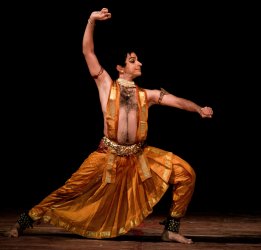  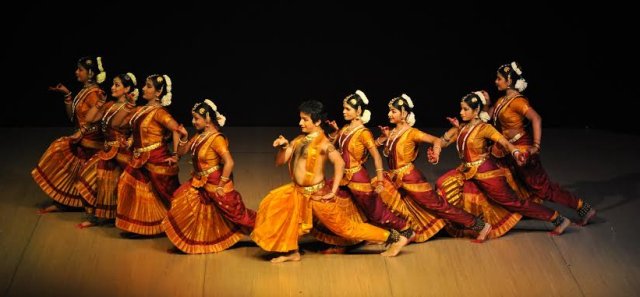 Within a minute Pavitra Bhat entered the stage with firm rhythmic steps, elegant movement and a spark in the eyes, holding his body in dignity with anjali mudra, offering obeisance to the deity and respects to the audience (he would have sought the blessings of his musicians as well, but here he was on recorded music) in Melaprapti with Alarippu and Ganesh Stuti in tune with the rhythm of cymbals and mridangam, which earlier used to be performed behind the curtain, I whispered to myself, ‘Judge not a dancer by gender, nor by age.’ The promise Pavitra eminently held out was fulfilled all through. In Shambhu Natanam attributed to Muni Patanjali, he vividly visualizes the varying familiar attributes, symbols and weapons of Lord Shiva, the Creator and the Sustainer. He goes on to do a refreshing piece Shadaksharam in praise of Lord Murugan, warrior son of Shiva and Parvati. This is followed by Shri Krishna Kamala Nato varnam in adi tala, depicting dramatic episodes from the illustrious life of Lord Krishna, divinely glowing and charming like Kamadev, now as Devaki’s son, now sucking life out of Putana’s breasts, now overcoming the might of Kaliya in the Yamuna river and as the wise guiding Sarathi with divine serenity singing the Bhagavad Geeta to the perplexed Arjuna in a dilemma in the battlefield and showing him the right path. Set to the same primary rhythm pattern is the stotram dedicated to Mahishasuramardini, Goddess of Shakti, who has her abode at the top of the Vindhyas and clears the universe of all evil forces so that tranquil joy permeates it. The concluding Tillana is again on the theme of good triumphing over evil, signified by Kalinga Narthana - even as a child, as the divine lore goes, Krishna benevolently overcomes evil. Except in the Varnam, Pavitra is with a bevy of pretty girls forming pleasing group compositions that complement and give life to his portrayals. With quicksilver changes in action, alone or centrally as part of a group, he vibrantly covers the whole stage with alacrity. More than this visible performance is the saattvika abhinaya that sets him apart as a dancer of potentially high calibre. He demonstrates with relative versatility masculine energy in varying rasas as also delicate feminine bhavas. Guru Deepak Mazumdar, who is known at times to provide nattuvangam to Pavitra’s dance recitals and even compere the presentation, must be proud of this young Mumbai-based disciple, who has had accolades too many for his age. May the endearing lad not get swerved by them and with dedication continue his sadhana, under the guidance of his knowledgeable guru! A tangible heritage is relatively easy to preserve with patronage. Preservation of the intangible heritage entails talent and dedication. Reassuringly, there is no dearth of both in the young generation. Conclusion It is exposure to such performances that dance learners add to what they learn at their centres. Gurus and teachers themselves, with a couple of exceptions every day, were conspicuous by their absence despite, I understand, being invited. They could have by their presence, I would in all modesty like to suggest, set an example to their students. One feels glad to learn at the same time that the hosts keep lobbying at arm’s length and use independent judgement in inviting performers. Dr. SD Desai, a professor of English, has been a Performing Arts Critic for many years. Among the dance journals he has contributed to are Narthaki, Sruti, Nartanam and Attendance. He guest-edited Attendance 2013 Special Issue. His books have been published by Gujarat Sahitya Academy, Oxford University Press and Rupa. After 30 years with a national English daily, he is now a freelance art writer. |